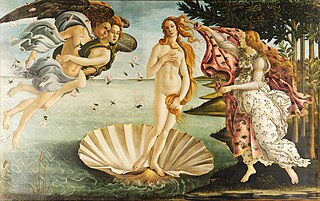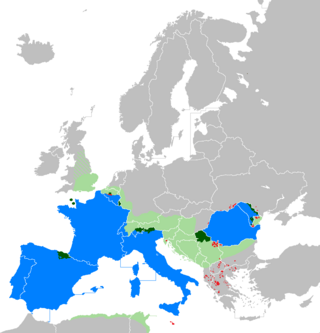
Greek is an independent branch of the Indo-European family of languages, native to Greece, Cyprus, Italy, southern Albania, and other regions of the Balkans, the Black Sea coast, Asia Minor, and the Eastern Mediterranean. It has the longest documented history of any Indo-European language, spanning at least 3,400 years of written records. Its writing system is the Greek alphabet, which has been used for approximately 2,800 years; previously, Greek was recorded in writing systems such as Linear B and the Cypriot syllabary. The alphabet arose from the Phoenician script and was in turn the basis of the Latin, Cyrillic, Coptic, Gothic, and many other writing systems.

Latin is a classical language belonging to the Italic branch of the Indo-European languages. Considered a dead language, Latin was originally spoken in Latium, the lower Tiber area around Rome. Through the expansion of the Roman Republic it became the dominant language in the Italian Peninsula and subsequently throughout the Roman Empire. Even after the fall of Western Rome, Latin remained the common language of international communication, science, scholarship and academia in Europe until well into the 18th century, when regional vernaculars supplanted it in common academic and political usage. For most of the time it was used, it would be considered a dead language in the modern linguistic definition; that is, it lacked native speakers, despite being used extensively and actively.

Neo-Latin is the style of written Latin used in original literary, scholarly, and scientific works, first in Italy during the Italian Renaissance of the fourteenth and fifteenth centuries, and then across northern Europe after about 1500, as a key feature of the humanist movement. Through comparison with Latin of the Classical period, scholars from Petrarch onwards promoted a standard of Latin closer to that of the ancient Romans, especially in grammar, style, and spelling. The term Neo-Latin was however coined much later, probably in Germany in the late 1700s, as Neulatein, spreading to French and other languages in the nineteenth century.

The Renaissance is a period in history and a cultural movement marking the transition from the Middle Ages to modernity, covering the 15th and 16th centuries and characterized by an effort to revive and surpass the ideas and achievements of classical antiquity; it occurred after the crisis of the Late Middle Ages and was associated with great social change in most fields and disciplines, including art, architecture, politics, literature, exploration and science. In addition to the standard periodization, proponents of a "long Renaissance" may put its beginning in the 14th century and its end in the 17th century. The traditional view focuses more on the Renaissance's early modern aspects and argues that it was a break from the past, but many historians today focus more on its medieval aspects and argue that it was an extension of the Middle Ages. The beginnings of the period—the early Renaissance of the 15th century and the Italian Proto-Renaissance from around 1250 or 1300—overlap considerably with the Late Middle Ages, conventionally dated to c. 1350–1500, and the Middle Ages themselves were a long period filled with gradual changes, like the modern age; as a transitional period between both, the Renaissance has close similarities to both, especially the late and early sub-periods of either.

Ancient Greek includes the forms of the Greek language used in ancient Greece and the ancient world from around 1500 BC to 300 BC. It is often roughly divided into the following periods: Mycenaean Greek, Dark Ages, the Archaic or Epic period, and the Classical period.

Medieval literature is a broad subject, encompassing essentially all written works available in Europe and beyond during the Middle Ages. The literature of this time was composed of religious writings as well as secular works. Just as in modern literature, it is a complex and rich field of study, from the utterly sacred to the exuberantly profane, touching all points in-between. Works of literature are often grouped by place of origin, language, and genre.
Old French was the language spoken in most of the northern half of France approximately between the late 8th and the mid-14th century. Rather than a unified language, Old French was a linkage of Romance dialects, mutually intelligible yet diverse. These dialects came to be collectively known as the langue d'oïl, contrasting with the langue d'oc in the south of France.

The Italian Renaissance was a period in Italian history covering the 15th and 16th centuries. The period is known for the initial development of the broader Renaissance culture that spread across Western Europe and marked the transition from the Middle Ages to modernity. Proponents of a "long Renaissance" argue that it started around the year 1300 and lasted until about 1600. In some fields, a Proto-Renaissance, beginning around 1250, is typically accepted. The French word renaissance means "rebirth", and defines the period as one of cultural revival and renewed interest in classical antiquity after the centuries during what Renaissance humanists labelled as the "Dark Ages". The Italian Renaissance historian Giorgio Vasari used the term rinascita ("rebirth") in his Lives of the Most Excellent Painters, Sculptors, and Architects in 1550, but the concept became widespread only in the 19th century, after the work of scholars such as Jules Michelet and Jacob Burckhardt.

Southern Europe is the southern region of Europe. It is also known as Mediterranean Europe, as its geography is marked by the Mediterranean Sea. Definitions of southern Europe include some or all of these countries and regions: Albania, Andorra, Bosnia and Herzegovina, Bulgaria, Croatia, Cyprus, Gibraltar, Greece, Italy, Kosovo, Malta, Monaco, Montenegro, North Macedonia, Portugal, San Marino, Serbia, Slovenia, southern France, Spain, Turkey, and Vatican City.

The Latin school was the grammar school of 14th- to 19th-century Europe, though the latter term was much more common in England. Other terms used include Lateinschule in Germany, or later Gymnasium. Latin schools were also established in Colonial America.

The langues d'oïl are a dialect continuum that includes standard French and its closest autochthonous relatives historically spoken in the northern half of France, southern Belgium, and the Channel Islands. They belong to the larger category of Gallo-Romance languages, which also include the historical languages of east-central France and western Switzerland, southern France, portions of northern Italy, the Val d'Aran in Spain, and under certain acceptations those of Catalonia.
A classical language is any language with an independent literary tradition and a large body of ancient written literature.

Medieval Latin was the form of Literary Latin used in Roman Catholic Western Europe during the Middle Ages. In this region it served as the primary written language, though local languages were also written to varying degrees. Latin functioned as the main medium of scholarly exchange, as the liturgical language of the Church, and as the working language of science, literature, law, and administration.

Renaissance literature refers to European literature which was influenced by the intellectual and cultural tendencies associated with the Renaissance. The literature of the Renaissance was written within the general movement of the Renaissance, which arose in 14th-century Italy and continued until the mid-17th century in England while being diffused into the rest of the western world. It is characterized by the adoption of a humanist philosophy and the recovery of the classical Antiquity. It benefited from the spread of printing in the latter part of the 15th century.
Apollonius of Tyre is the hero of a short ancient novel, popular in the Middle Ages. Existing in numerous forms in many languages, all are thought to derive from an ancient Greek version now lost.

The Renaissance of the 12th century was a period of many changes at the outset of the High Middle Ages. It included social, political and economic transformations, and an intellectual revitalization of Western Europe with strong philosophical and scientific roots. These changes paved the way for later achievements such as the literary and artistic movement of the Italian Renaissance in the 15th century and the scientific developments of the 17th century.

With the rediscovery of classical antiquity in the Renaissance, the poetry of Ovid became a major influence on the imagination of poets and artists, and remained a fundamental influence on the diffusion and perception of classical mythology through subsequent centuries. From the early years of the Renaissance, artists portrayed subjects from Greek and Roman mythology alongside more conventional Christian themes. Among the best-known subjects of Italian artists are Botticelli's Birth of Venus and Pallas and the Centaur, the Ledas of Leonardo da Vinci and Michelangelo, and Raphael's Galatea. Through the medium of Latin and the works of Ovid, Greek myth influenced medieval and Renaissance poets such as Petrarch, Boccaccio and Dante in Italy.
The following outline is provided as an overview of and topical guide to the Renaissance:

The legacy of the Roman Empire has been varied and significant. The Roman Empire, itself built upon the legacy of other cultures, has had long-lasting influence with broad geographical reach on a great range of cultural aspects, including state institutions, law, cultural values, religious beliefs, technological advances, engineering, and language.














